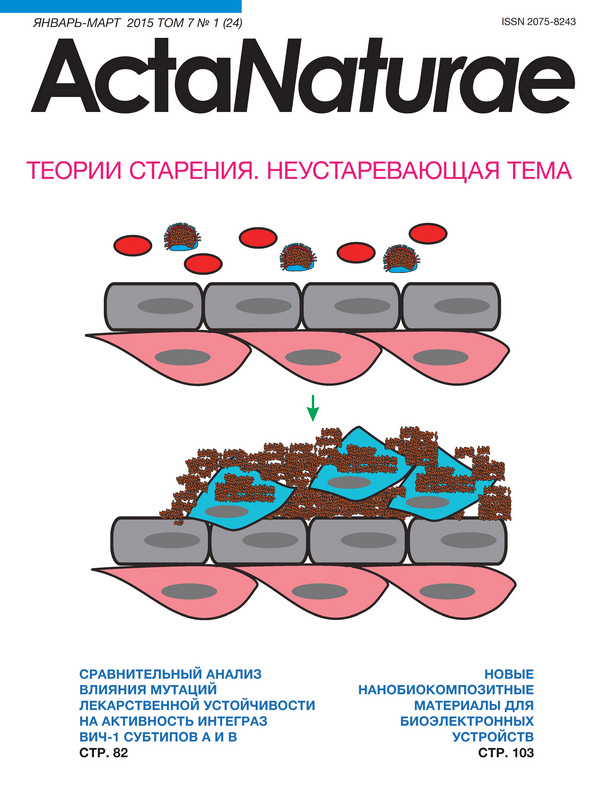Interaction with Serum Albumin As a Factor of the Photodynamic Efficacy of Novel Bacteriopurpurinimide Derivatives
Authors:
Аkimova А.V. 1 , Rychkov G.N. 2 ,3 , Grin М.А. 4 , Filippova N.A. 5 , Golovina G.V. 1 , Durandin N.A. 1 , Vinogradov A.M. 1 , Коkrashvili Т.А. 6 , Mironov А.F. 4 , Shtil А.А. 5 , Кuzmin V.А. 1
Affiliations:
N.M. Emanuel Institute of Biochemical Physics
Petersburg Nuclear Physics Institute
St.Petersburg State Polytechnical University
M.V. Lomonosov Moscow State University of Fine Chemical Technologies
N.N. Blokhin Russian Cancer Research Center
Georgian Technical University
Issue: Vol 7, No 1 (2015)Pages: 109-116Section:
Research Articles
Submitted: 17.01.2020Published: 15.03.2015URL: https://actanaturae.ru/2075-8251/article/view/10519 DOI: https://doi.org/10.32607/20758251-2015-7-1-109-116 ID: 10519
Cite item
Abstract
Optimization of the chemical structure of antitumor photosensitizers (PSs) is aimed at increasing their affinity to a transport protein, albumin and irreversible light-induced tumor cell damage. Bacteriopurpurinimide derivatives are promising PSs thanks to their ability to absorb light in the near infrared spectral region. Using spectrophotometry, we show that two new bacteriopurpurinimide derivatives with different substituents at the N atoms of the imide exocycle and the pyrrole ring A are capable of forming non-covalent complexes with human serum albumin (HSA). The association constant (calculated with the Benesi-Hildebrand equation) for N-ethoxybacteriopurpurinimide ethyloxime (compound 1) is higher than that for the methyl ether of methoxybacteriopurpurinimide (compound 2) (1.18×10 5 M-1 vs. 1.26×10 4 M -1, respectively). Molecular modeling provides details of the atomic interactions between 1 and 2 and amino acid residues in the FA1 binding site of HSA. The ethoxy group stabilizes the position of 1 within this site due to hydrophobic interaction with the protein. The higher affinity of 1 for HSA makes this compound more potent than 2 in photodynamic therapy for cultured human colon carcinoma cells. Photoactivation of 1 and 2 in cells induces rapid (within a few minutes of irradiation) necrosis. This mechanism of cell death may be efficient for eliminating tumors resistant to other therapies.
References
Phillips D. // Int. Rev. J. 1997, V.22, №3-4, P.3-50
Ashur I., Goldschmidt R., Pinkas I., Salomon I., Szewczyk G., Sarna T., Scherz A. // J. Phys. Chem. A. 2009, V.113, P.8027-8037
Josefsen L.B., Boyle R.W. // Theranostics. 2012, V.3, №9, P.916-966
Chen Y., Li G., Pandey R.K. // Curr. Org. Chem. 2004, №8, P.1105-1134
Moisenovich M.M., Ol’shevskaya V.A., Rokitskaya T.I., Ramonova A.A., Nikitina R.G., Savchenko A.N., Tatarskiy V.V., Kaplan M.A., Kalinin V.N., Kotova E.A. // PLoS ONE.2010. V. 5, 2010, V.5, №9, P.e12717
Grin M.A., Mironov A.F., Shtil A.A. // Anti-Cancer Agents Med. Chem. 2008, V.8, №6, P.683-697
Oertel M.l., Schastak S.I., Tannapfel A., Hermann R., Tannapfel A., Hermann R., Sack U., Mossner J., Berr F. // J. Photochem. Photobiol. B: Biology. 2003, V.71, P.1-10
Dąbrowski J.M., Arnaut L.G., Pereira M.M., Urbańska K., Simões S., Stochel G., Cortes L. // Free Rad. Biol. Med. 2012, V.52, P.1188-1200
Meerovich I.G.., Grin M.A., Tsiprovskiy A.G., Meerovich G.A., Oborotova N.A., Loschenov V.B., Baryshnikov A.Y., Mironov A.F. // Russian Biotherapeutic J. 2007, V.6, №1, P.22
Ol’shevskaya V.A., Nikitina R.G., Guiul’malieva M.A., Zaitsev A.V., Luzgina V.N., Kononova E.G., Ivanov O.G., Burmistrova N.V., Kaplan M.F., Kalinin V.N. // Org. Biomol. Chem. 2006, V.4, P.3815-3821
Ol’shevskaya V.A., Nikitina R.G., Savchenko A.N., Malshakova M.V., Vinogradov A.M., Golovina G.V., Belykh D. V., Kutchin A.V., Kaplan M.A., Kalinin V.N. // Bioorg. Med. Chem. 2009, V.17, №3, P.1297-1306
Ol’shevskaya V.A., Savchenko A.N., Zaitsev A. V., Kononova E. G., Petrovskii P.V., Ramonova A.A., Tatarskiy V.V. Jr., Moisenovich M.M., Kalinin V.N., Shtil A.A. // J. Organometal. Chem. 2009, V.694, №11, P.1632-1637
Pshenkina N.N. // Med. Academ. J. 2011, V.11, №3, P.3-15
Sharman W.M., van Lier J.E., Allen C.M. // Adv. Drug Delivery Rev. 2004, V.56, P.53-76
Tsuchida T., Zheng G., Pandey R.K., Potter W.R., Bellnier D.A., Henderson B.W., Kato H., Dougherty T.J. // Photochem. Photobiol. 1997, V.66, №2, P.224-228
Mironov A.F., Grin M.A., Tsiprovskiy A.G., Meerovich G.A., Meerovish I.G., Oborotova N.A., Treshalina E.M., Loschenov V.B., Baryshnikov A.Y., Tsigankov A.A. // Patent of Russia № 2411943. Bull. № 29. 2011
Mironov A.F., Grin M.A., Tsiprovskiy A.G. // J. Porph. Phthalocyan. 2002, V.6, №5, P.358-361
Benesi H.A., Hildebrant J.H. // J. Am. Chem. Soc. 1949, V.71, P.2703-2707
Abagyan R., Totrov M., Kuznetsov D. // J. Comput. Chem. 1994, V.15, P.488-506
Hanwell M.D., Curtis D.E., Lonie D.C., Vandermeersch T., Zurek E., Hutchison G.R. // J. Chem. Inform. 2012, V.4, №1, P.17
Schmidt M.W., Baldridge K.K., Boatz J.A., Elbert S.T., Gordon M.S., Jensen J.H., Koseki S., Matsunaga N., Nguyen K.A., Su S., Windus T.L., Dupuis M., Montgomery J.A. // J. Comput. Chem. 1993, V.14, №11, P.1347-1363
Huzinaga S., Andzelm J., Klobukowski M., Radzio-Andzelm E., Sakai Y., Tatewaki H. // Gaussian Basis Sets for Molecular Calculations.Amsterdam: Elsevier 1984, P.240
Roothaan C.C.J. // Rev. Modern Phys. 1951, V.23, №2, P.69
Wardell M., Wang Z., Ho J.X., Robert J., Ruker F., Ruble J., Carter D.C. // Biochem. Biophys. Res. Commun. 2002, V.291, №4, P.813-819
Fernández-Recio J., Totrov M., Abagyan R. // Proteins: Structure, Function, and Bioinformatics. 2003, V.52, №1, P.113-117
Totrov M. and Abagyan R. // Proteins. 1997, S1, P.215-220
Totrov M., Abagyan R. // Peptide Sci. 2001, V.60, №2, P.124-133
Eisfeld A., Briggs J.S. // Chem. Phys 2006, V.324, P.376-384
Yao-Bing Y., Wang Y.N., Ma J.B. // Spectrochim. Acta 2006, V.64, PtA, P.1032-1038
Ascenzi P., Fasano M. // IUBMB Life. 2009, V.61, №12, P.1118-1122
Garg A.D., Bose M., Ahmed M.I., Bonass W.A., Wood S.R. // PLoS ONE. 2012, V.7, №4, P.e34475
Chin W.W., Heng P.W., Bhuvaneswari R., Lau W.K., Olivo M. // Photochem. 2006, №5, P.1031-1037
Calin M.A., Paraska S.V. // J. Optoelectron. Adv. Mat. 2006, V.8, №3, P.1173-1179
Evans C.L., Abu-Yousif Adnan O., Jin P. Yong., Klein O.J., Celli J.P., Rizvi I., Zheng X., Hasan T. // PLoS ONE. 2011, V.6, №8, P.e23434
Supplementary files
Supplementary Files
Action
1.
JATS XML
Copyright (c) 2015 Аkimova А.V., Rychkov G.N., Grin М.А., Filippova N.A., Golovina G.V., Durandin N.A., Vinogradov A.M., Коkrashvili Т.А., Mironov А.F., Shtil А.А., Кuzmin V.А.
This work is licensed under a
Creative Commons Attribution 4.0 International License .







